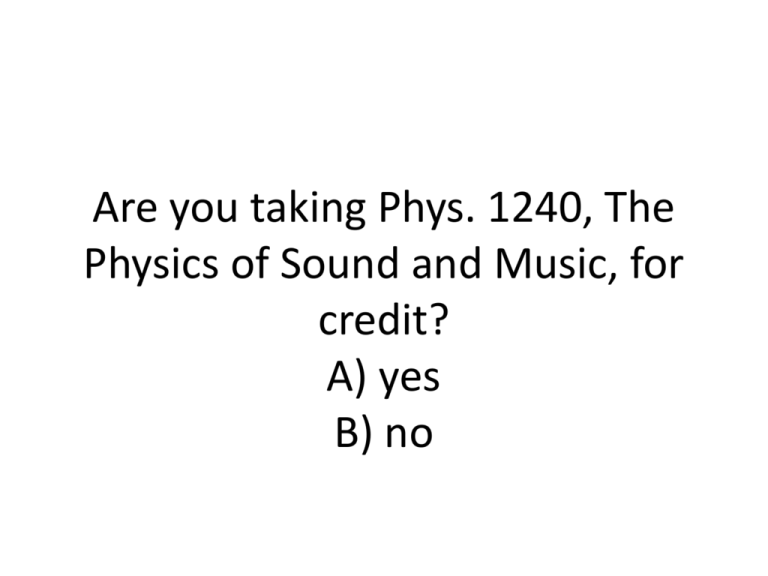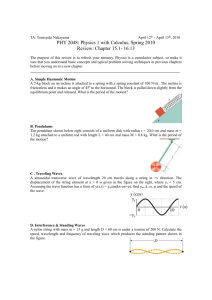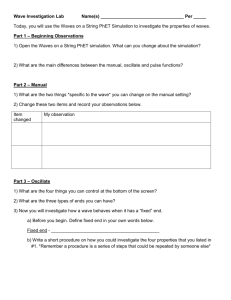Lecture File 01
advertisement

Are you taking Phys. 1240, The Physics of Sound and Music, for credit? A) yes B) no Welcome to PHYS 1240 Sound and Music Professor Allen Hermann Cell Phones off Clickers on M T W 7-8 L1 Sound, Oscillations, Waves, Graphs Ch.1,2,S R F 7-9 L2 Forces, Mass, Acceleration, Pressure, Review of Exponents Ch.1,2, S 7-14 L5 Sound 7-15 L6 Wave 7-16 L7 The Human Waves, Frequency, Intensity, Sound Level, Ear, Threshold of Pitch, Tone Quality Decibels Hearing and Harmonics Ch.5 Ch.6 Ch.2,8,S 7-21 L10 The Just 7-22 L11 Modes and 7-23 Midterm Exam Scale, The Non-western Scales Tempered Scale Ch.19,S Ch.18,S 7-10 L3 Restoring Forces, Energy, Power Ch.1,2,S 7-28 L14 Vibrating 7-29 L15 Brass Air Columns, Instruments Organs, Flutes Ch.3,13,S Ch.3,12,13 7-31 L17 Woodwinds 8-01 L18 Auditorium continued, The Human and Room Acoustics Voice Ch.15 Ch.3,13,14,S 8-04 L19 Auditorium and Room Acoustics continued Ch.15 8-05 L20 Electronic Sound, Analog and Digital Devices Ch.16,S 7-30 L16 Brass Instruments continued, Woodwinds Ch,3,13,S 8-06 L21 Electronic Sound continued, Sampling, CD players and MP3 compression, Ch.16,S 7-11 L4 Oscillations and Waves Revisited, Interference, Waves on a String Ch.2,4,S 7-17 L8 Musical Scales, 7-18 L9 Pythagorean Chords, Intervals Scales Ch.7,19 Ch.18,S 7-24 L12 String Instruments, Harmonics, the Piano Ch.3,8,10,11 8-07 Review for the Final Exam 7-25 L13 Vibrating Rods and Membranes, Percussion Instruments Ch.3,9 8-8 Final Exam Grades Mid-term exam……….25% Final exam……………...35% Homework………………30% Class participation (clicker) ..........…….10% Total……………………….100% Exam dates: Wed. July 23 midterm Fri. Aug.8 final CT 1.0.1 What instrument have you played? (If you have played several, which one the most?) a) b) c) d) e) piano guitar any other instrument with strings any wind instrument never played any instrument What is sound? Sound is produced by periodic vibrations, but we need a medium as well for the sound to propagate. Sound is different from light in that it cannot travel in empty space. So an explosion of a distant star would never be heard by us on earth. Sound travels as mechanical waves, through solids liquids and gases. So to understand sound, we must understand periodic vibrations or oscillations (the source of sound), the movement of the disturbance which these vibrations cause through a material medium (sound wave), and the reception of this disturbance by, e.g. the ear. Graphs The slope is the speed (discuss the term “velocity”). In the last slide the initial slope corresponds to about 180 m traversed in about 3 minutes (180 sec), or the initial speed is about 180m/180 sec= 1 m/s In the period between second 6 and second 9, the student’s speed is a) faster than the initial speed b) slower than the initial speed c) the same as the initial speed PhET simulations you should gain access at phet.colorado.edu go to Play with SIMS we will do The Moving Man To learn about Periodic Vibrations or Oscillations, we must first learn about Forces A little about Vectors The bigger the weight (force on the spring), the more the spring extends and the more the spring “pulls back”, i.e. the greater the restoring force. We can write the restoring force Fr is proportional to the extension x, Fr=-kx PhET Masses and Springs PhET Pendulum Lab Consider the pendulum shown in the simulation. What happens at the extreme end of its motion? A) The pendulum speeds up. B) The pendulum comes to a momentary full stop. C) The pendulum reaches its maximum frequency. D) The pendulum reaches its minimum angle with respect to a vertical line. E) The pendulum’s weight increases. Simple Harmonic Motion • Position x vs. time t • Definition of period T • Definition of amplitude A SHM Systems Let the period be T (in seconds). The number of times the vibrating source executes SHM in one second (i.e. the frequency, f, units of Hz)) is 1/T. For example, if T is 0.1 s, f is just 1/0.1=10 Hz Frequency and Period f = 1/T or T = 1/f or f T =1 T period, in seconds (s) f = frequency in Hertz (Hz) Metric prefixes: centi- (c), milli- (m), micro- (m) kilo- (k), mega- (M) CT 2.1.8 Looking at the following waveform, what is the period? Amplitude 0 a) 1 sec b) 2 sec c) 1 m/s d) 2 m/s e) Not enough information 1 2 time (sec) CT 2.1.2 When the amplitude of an oscillating object is doubled, the period becomes: a) twice as big b) 1/2 as big c) Stays the same d) 1/4 times as big e) Not enough information to decide When the frequency is doubled, the period becomes… Pulses and Waves Phet Wave on a String Pulse propagation CT 1.3.3x I grab the left end of a LONG string and wiggle it up and down. There is a purple painted spot somewhere on the string. What choice below best shows the motion of the purple spot? A) (up and down) B) (pushed steadily to the right) C) (left and right) D) E) (no motion) (circular path) PhET Wave on a String Periodic Oscillations or Vibrations Wave velocity for a periodic vibration Let the wavelength be λ and the frequency of the vibration be f. The wave velocity v is just V=λ/T, or V= λf CT 2.1.10 The wavelength, λ, is 10 m. What is the speed of this wave? Amplitude 0 a) b) c) d) e) Time (sec) 1 1 m/s 7 m/s 10 m/s 15 m/s None of the above/not enough info? What determines the velocity of a transverse pulse or wave on a string (v=λf simply constrains f and λ) ? The velocity is determined by the tension T ( a force in N) applied to the string, and the mass per unit length μ ( in kg/m). v T /m








